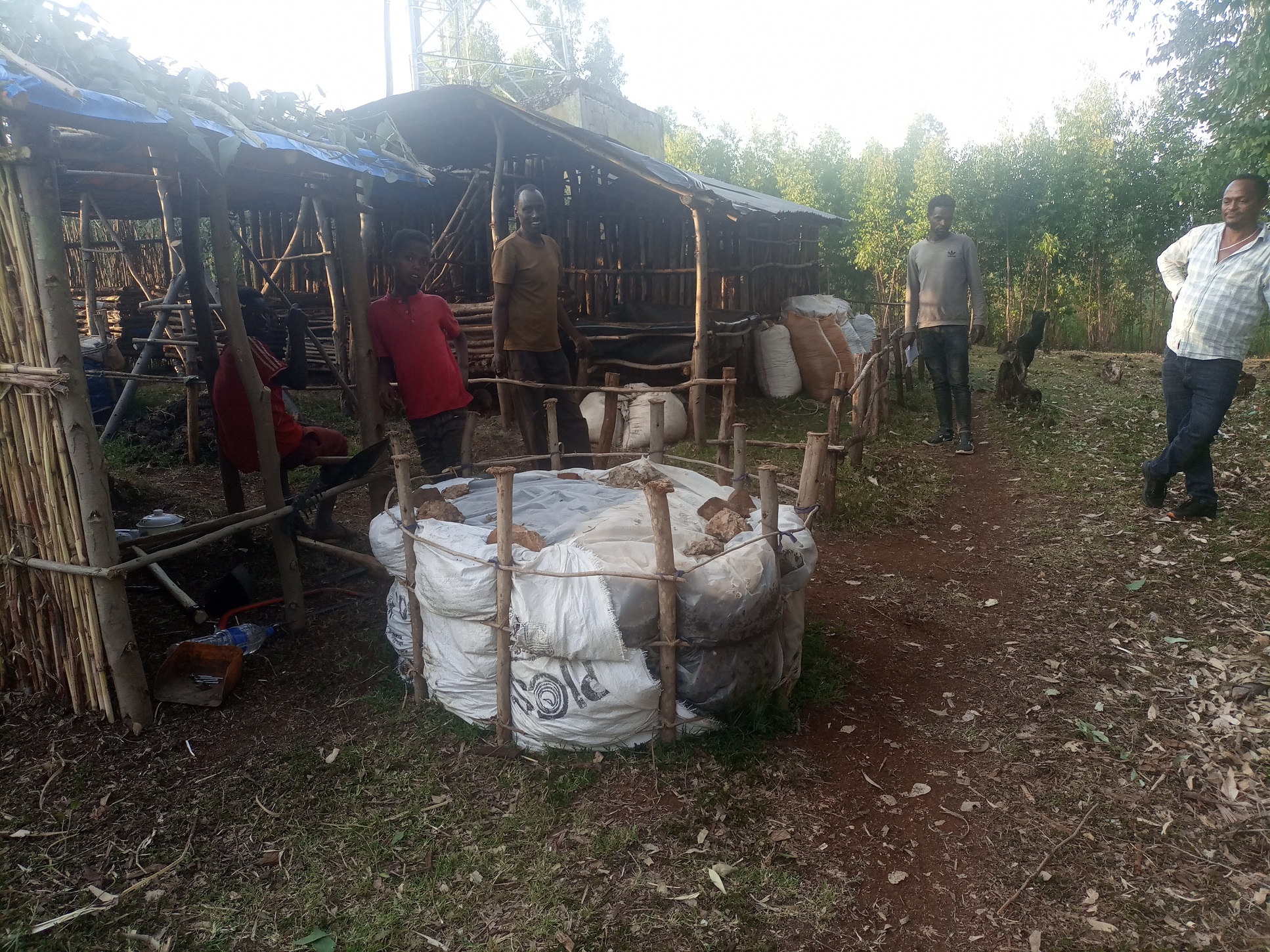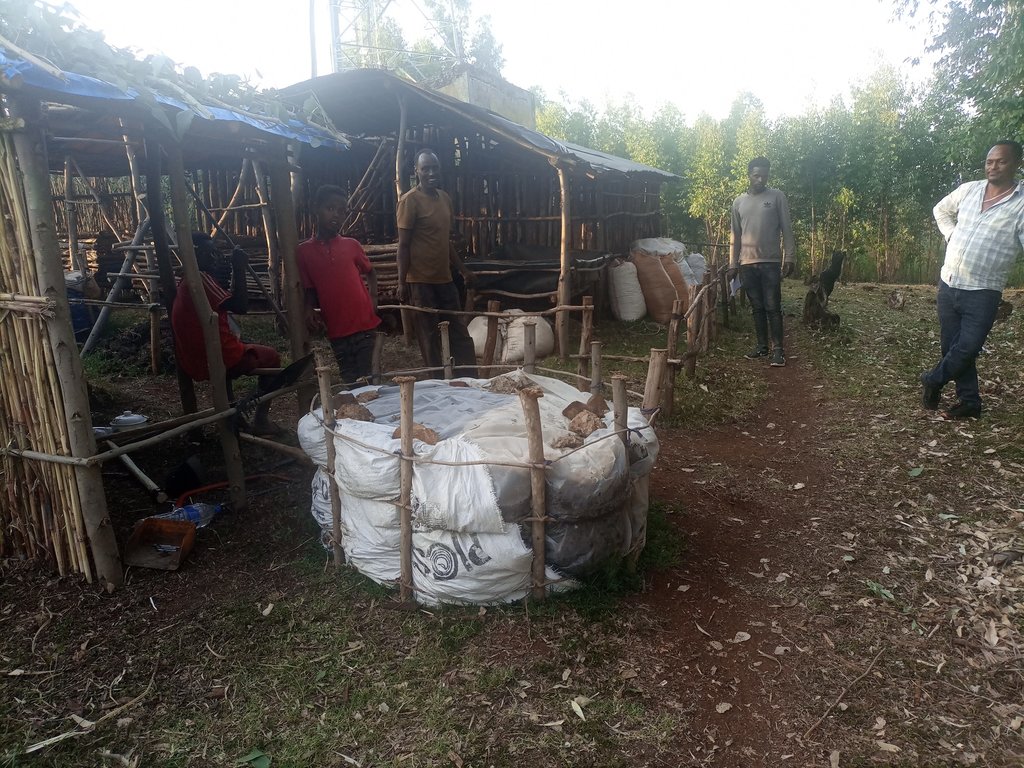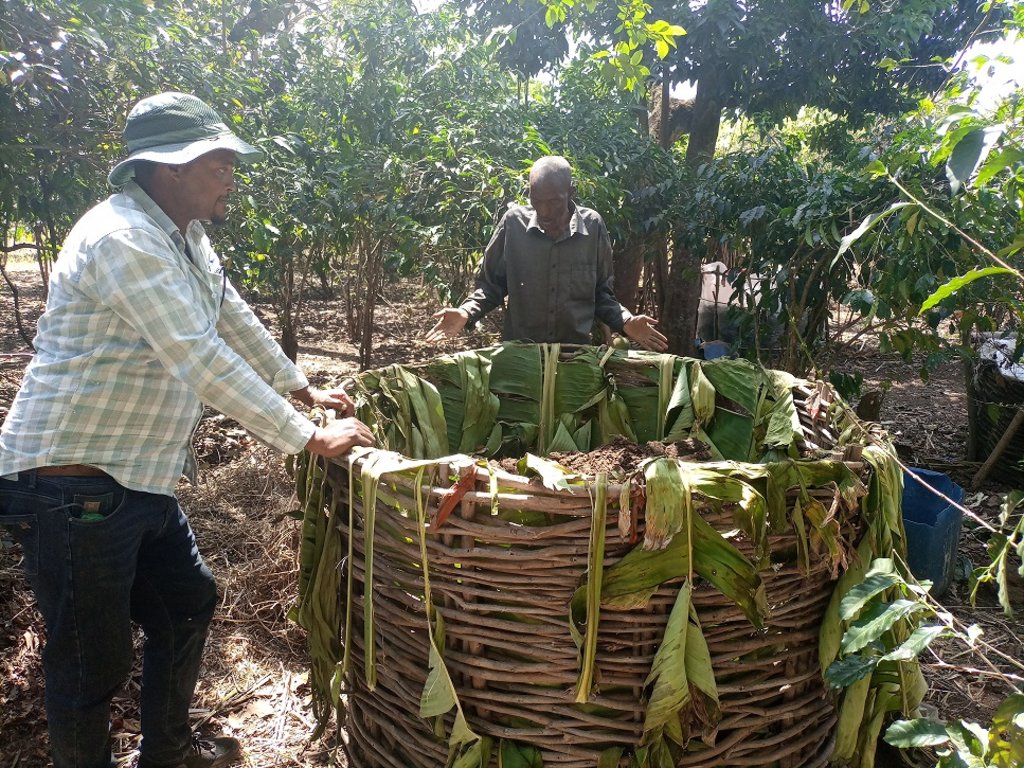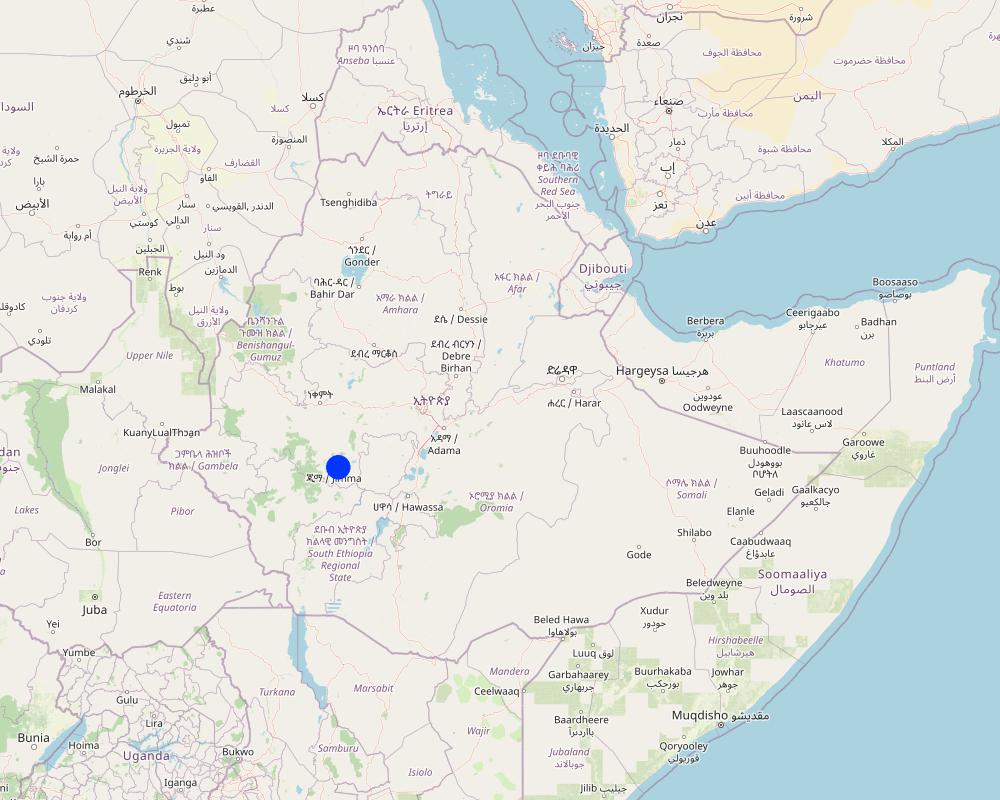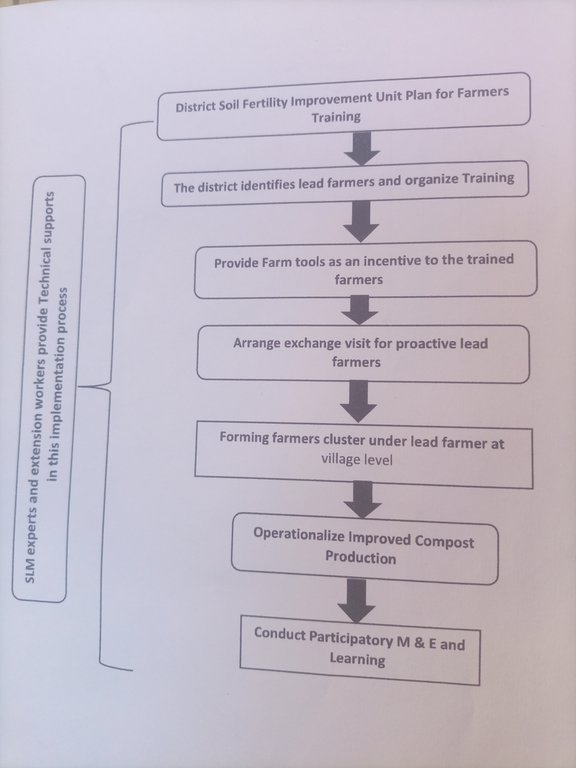Soil Fertility Improvement Cluster [เอธิโอเปีย]
- ผู้สร้างสรรค์:
- การอัพเดท:
- ผู้รวบรวม: GERBA LETA
- ผู้เรียบเรียง: Noel Templer, Julia Doldt, Kidist Yilma, Tabitha Nekesa, Ahmadou Gaye, Siagbé Golli
- ผู้ตรวจสอบ: William Critchley, Rima Mekdaschi Studer, Sally Bunning
Foyyainsaa Gabbina Biyyee gareedhan
approaches_6653 - เอธิโอเปีย
ดูส่วนย่อย
ขยายทั้งหมด ย่อทั้งหมด1. ข้อมูลทั่วไป
1.2 รายละเอียดที่ติดต่อได้ของผู้รวบรวมและองค์กรที่เกี่ยวข้องในการประเมินและการจัดเตรียมทำเอกสารของแนวทาง
วิทยากรหลัก
ผู้เชี่ยวชาญ SLM:
Gebeyehu Bekabil
+251 917 94 10 38
bekabil112@gmail.com
Kersa District Office of Agriculture
Jimma Zone, Oromia
เอธิโอเปีย
ชื่อของโครงการซึ่งอำนวยความสะดวกในการทำเอกสารหรือการประเมินแนวทาง (ถ้าเกี่ยวข้อง)
Soil protection and rehabilitation for food security (ProSo(i)l)ชื่อของโครงการซึ่งอำนวยความสะดวกในการทำเอกสารหรือการประเมินแนวทาง (ถ้าเกี่ยวข้อง)
CIAT International Center for Tropical Agriculture (CIAT International Center for Tropical Agriculture) - เคนยา1.3 เงื่อนไขที่เกี่ยวข้องกับการใช้ข้อมูลที่ได้บันทึกไว้ผ่านทาง WOCAT
วันที่เก็บรวบรวมข้อมูล (ภาคสนาม):
09/02/2023
ผู้รวบรวมและวิทยากรหลักยอมรับเงื่อนไขเกี่ยวกับการใช้ข้อมูลที่ถูกบันทึกผ่านทาง WOCAT:
ใช่
1.4 การอ้างอิงถึงแบบสอบถามเรื่องเทคโนโลยี SLM
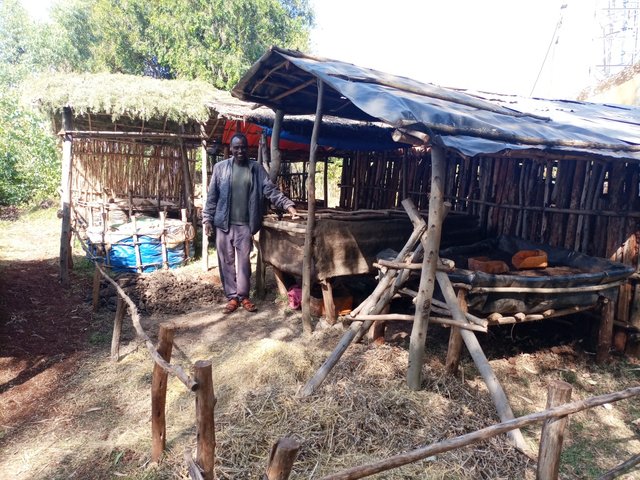
Improved Compost [เอธิโอเปีย]
Improved compost making using “static pile” systems transforms organic material from plants and/or animals into high-value, rich organic compost. It demands less labour, and less time to reach maturity than conventional systems as it thoroughly mixes the ingredients at the beginning which precludes the need to turn the heap later.
- ผู้รวบรวม: GERBA LETA
2. คำอธิบายของแนวทาง SLM
2.1 การอธิบายแบบสั้น ๆ ของแนวทาง
The Soil Fertility Improvement Cluster approach engages five or more farmers living in a village who share skills and labour to prepare and use improved compost as well as to demonstrate it to non-member of the group.
2.2 การอธิบายอย่างละเอียดของแนวทาง
การอธิบายอย่างละเอียดของแนวทาง:
The Soil Fertility Improvement Cluster approach engages five or more farmers living in a village who share skills and labour. Soil fertility improvement interventions in Kersa district of Jimma zone follows this approach. A cluster introduces diverse benefits to the participants including access to a package of inputs, and other benefits and services. Furthermore, it creates awareness and facilitates the adoption and diffusion of various soil fertility improvement technologies such as the preparation and use of improved compost. Kersa district, as one of the scaling out woredas for the Integrated Soil Fertility Management Project (ISFM+), strives to spread appropriate technologies against the growing issues of soil degradation, particularly soil acidity. The approach aims to promote collective learning and action where labour is shared amongst the participating farmers.
The district/Woreda Office of Agriculture’s Soil Fertility Improvement Unit organises annual training for 20 to 40 model farmers from different kebeles, of which five or more are located in the same village and can form a cluster. At the end of the training, the woreda office of agriculture donates a spade or other farm tool as an incentive to engage the participants in the preparation of organic fertilizers such as improved compost and vermicompost. Strict follow-up is carried out, with technical support provided by woreda development actors.
On top of the training organized on improved soil fertility by the woreda office of agriculture experts, a local NGO known as “FC Ethiopia” provides experience exchange visits to other parts of Oromia where improved compost was piloted. This technology involves different activities for the production of improved compost (described in detail as a Technology in the WOCAT database). Farmers' participation in training, exchange visits, collective learning and action, and lessons learning from the actual use of this organic fertilizer vis-à-vis using synthetic fertilizers motivates farmers to uptake and implement the technology. Land users like the simplicity of preparing the compost which takes less time than conventional compost preparation.
2.3 รูปภาพของแนวทาง
ข้อสังเกตทั่วไปเกี่ยวกับรูปภาพ:
The photo shows an improved compost production structure. The farmer demonstrates how different ingredients are mixed and piled in the structure to prepare organic fertilizer that improves the fertility as well as the acidity of the soil.
2.4 วีดีโอของแนวทาง
ความคิดเห็น อธิบายสั้นๆ:
Video of the approach was not taken.
2.5 ประเทศ ภูมิภาค หรือสถานที่ตั้งที่ได้นำแนวทางไปใช้
ประเทศ:
เอธิโอเปีย
ภูมิภาค/รัฐ/จังหวัด: :
Oromia, Jimma zone
ข้อมูลเฉพาะเพิ่มเติมของสถานที่ตั้ง:
Babo kebele
ความคิดเห็น:
The production cluster is located near the highway from the district capital, Serbo to Jimma city.
Map
×2.6 วันที่เริ่มต้นและสิ้นสุดของแนวทาง
ระบุปีที่เริ่ม:
2022
ความคิดเห็น:
The technology is at the pilot stage. So, it is believed to continue by the farmers themselves with technical support and backstopping services from the Woreda Office of Agriculture soil fertility improvement unit staff.
2.7 ประเภทของแนวทาง
- เป็นนวัตกรรมท้องถิ่นล่าสุด/ นวัตกรรมใหม่
2.8 เป้าหมายหรือวัตถุประสงค์หลักของแนวทาง
To learn and prepare improved compost in a group, and restore the increasingly growing problems of soil acidity, the main causes of soil degradation in the area.
2.9 เงื่อนไขที่เอื้ออำนวยหรือเป็นอุปสรรคต่อการนำเทคโนโลยีภายใต้แนวทางนี้ไปปฏิบัติใช้
การมีไว้ให้หรือการเข้าถึงแหล่งการเงินและบริการ
- เอื้ออำนวย
It enables land users to easily source some necessary materials such as polyethylene sheet.
การจัดตั้งระดับองค์กร
- เอื้ออำนวย
Cluster formation at the local level enables collective learning and labor sharing among the participant farmers.
การร่วมมือหรือการทำงานประสานกันของผู้ลงมือปฏิบัติ
- เอื้ออำนวย
Simplify group learning and scaling up/out of the technology at a larger scale.
ความรู้เกี่ยวกับ SLM การเข้าถึงการสนับสนุนด้านเทคนิค
- เอื้ออำนวย
Farmers' cluster or group approach improves access to technologies and technical support. Moreover, it improves farmer knowledge about SLM.
ตลาด (จัดซื้อปัจจัยนำเข้า ขายผลิตภัณฑ์) และราคา
- เอื้ออำนวย
It enables the farmers to produce surplus organic fertilizer and sell it out to those who require it.
ปริมาณงานที่ทำได้ กำลังคนที่มีให้
- เอื้ออำนวย
The availability of family labor simplifies the production and use of improved compost.
- เป็นอุปสรรค
The workload and shortage of family labor have a negative effect on the preparation of improved compost.
3. การมีส่วนร่วมและบทบาทของผู้มีส่วนได้ส่วนเสียที่เกี่ยวข้อง
3.1 ผู้มีส่วนได้ส่วนเสียที่เกี่ยวข้องในแนวทางนี้และบทบาท
- ผู้ใช้ที่ดินระดับท้องถิ่นหรือชุมชนระดับท้องถิ่น
Farmers
Collective learning and labor sharing.
- ผู้เชี่ยวชาญ SLM หรือที่ปรึกษาการเกษตร
Woreda SLM experts and Kebele extension workers.
Technical support and provision of advisory service.
- องค์กรพัฒนาเอกชน
FC Ethiopia
Arranged experience exchange visit for few farmers.
3.2 การเกี่ยวข้องของผู้ใช้ที่ดินระดับท้องถิ่นหรือชุมชนระดับท้องถิ่นในช่วงต่างๆของแนวทาง
| ความเกี่ยวข้องของผู้ใช้ที่ดินระดับท้องถิ่นหรือชุมชนระดับท้องถิ่น | ระบุผู้ที่มีส่วนเกี่ยวข้องและอธิบายกิจกรรม | |
|---|---|---|
| การริเริ่มหรือการจูงใจ | ปฏิสัมพันธ์ | SLM experts and extension workers provide technical support, and a group of farmers jointly learn and implement the technology. |
| การวางแผน | ปฏิสัมพันธ์ | Extension workers engage in the planning process. |
| การดำเนินการ | ระดมกำลังด้วยตนเอง | Farmers are keen to learn and implement the technology via group steering and self-mobilization. |
| การติดตามตรวจสอบหรือการประเมินผล | ปฏิสัมพันธ์ | Woreda SLM experts, extension workers, and farmers engaged in participatory evaluation and learning in a cluster. |
3.3 แผนผังแสดงขั้นตอนการทำงาน (ถ้ามี)
3.4 การตัดสินใจเลือกใช้เทคโนโลยี SLM
ระบุผู้ที่ทำการตัดสินใจเลือกเทคโนโลยีมากกว่าหนึ่งวิธีไปปฏิบัติใช้:
- ผู้ใช้ที่ดินเป็นผู้ตัดสินใจหลัก โดยการสนับสนุนจากผู้เชี่ยวชาญ SLM
ระบุว่าการตัดสินใจตั้งอยู่บนพื้นฐานของ:
- สิ่งที่ค้นพบจากงานวิจัย
- ประสบการณ์และความคิดเห็นส่วนตัว (ไม่ได้ลงบันทึกไว้)
4. การสนับสนุนด้านเทคนิค การสร้างขีดความสามารถ และการจัดการด้านความรู้
4.1 การสร้างขีดความสามารถ / การอบรม
ได้มีการจัดอบรมให้แก่ผู้ใช้ที่ดินหรือผู้มีส่วนได้ส่วนเสียคนอื่น ๆ หรือไม่:
ใช่
ให้ระบุว่าใครเป็นผู้ได้รับการอบรม:
- ผู้ใช้ที่ดิน
- เจ้าหน้าที่ภาคสนาม / ที่ปรึกษา
ถ้าเกี่ยวข้อง ให้ระบุ เพศ อายุ สถานภาพ ชาติพันธุ์ เป็นต้น:
A few women farmers participated in the training among other men counterparts.
รูปแบบการอบรม:
- กำลังดำเนินการ
หัวข้อที่พูด:
Improving soil fertility using organic fertilizers, acid soil management, crop residue management, crop rotation, etc.
4.2 การบริการให้คำแนะนำ
ผู้ใช้ที่ดินมีการเข้าถึงการรับบริการให้คำปรึกษาหรือไม่:
ใช่
ระบุว่ามีบริการให้คำปรึกษาหรือไม่:
- ไปเยี่ยมชมสถานที่
- ที่ศูนย์ถาวร
การอธิบาย/แสดงความคิดเห็น:
Advisory service is often given at Farmers Training Center (FTC) and complemented by field visit and provision of on- the- spot technical support and counseling services.
4.3 การเสริมความแข็งแกร่งให้กับสถาบัน (การพัฒนาองค์กร)
สถาบันได้รับการจัดตั้งขึ้นมาหรือเสริมความแข็งแกร่งโดยแนวทางนี้หรือไม่:
- ใช่ เล็กน้อย
ระบุระดับของสถาบันที่ได้รับการเสริมความแข็งแกร่งหรือจัดตั้งขึ้นมา:
- ท้องถิ่น
อธิบายถึงสถาบัน บทบาทและความรับผิดชอบ สมาชิก เป็นต้น:
Farmers cluster (soil fertility improvement group). Member farmers jointly learn the technique of producing organic fertilizers, SLM practices, and sharing labor during the time of applying the fertilizer to the farm.
ระบุประเภทของการให้ความช่วยเหลือสนับสนุน:
- การสร้างขีดความสามารถ / การอบรม
4.4 การติดตามตรวจสอบและประเมินผล
การติดตามตรวจสอบและประเมินผลเป็นส่วนหนึ่งของแนวทางหรือไม่:
ใช่
ความคิดเห็น:
The monitoring and evaluation are conducted by Woreda SLM experts and seldom with member of the woreda administration and the land users.
ถ้าตอบว่าใช่ แสดงว่าการจัดเตรียมเอกสารนี้มุ่งหวังที่จะเอาไปใช้สำหรับการติดตามตรวจสอบและประเมินผลใช่หรือไม่:
ไม่ใช่
ความคิดเห็น:
As the district/woreda is one of the scaling up woredas for the ISFM+ project, it may/may not be used for the documentation.
4.5 การวิจัย
การวิจัยเป็นส่วนหนึ่งของแนวทางหรือไม่:
ไม่ใช่
5. การสนับสนุนด้านการเงินและวัสดุอุปกรณ์
5.1 ระบุงบประมาณประจำปีสำหรับแนวทาง SLM นี้
ถ้าหากว่างบประมาณประจำปีไม่เป็นที่ทราบแน่นอน ให้ระบุช่วงลงไป:
- 2,000-10,000
แสดงความคิดเห็น (แหล่งของการระดมทุน ผู้บริจาคคนสำคัญ):
Actually, specific data for operational data is not available at the level of the compost production cluster since the training and exchange visits were organized by the woreda office of Agriculture and an NGO. Of course, there are huge labor costs spent by land users to access the feedstock. Also, materials/accessories and farm tools cost for compost production was not precisely accounted for.
5.2 การสนับสนุนด้านการเงิน / วัสดุอุปกรณ์ให้แก่ผู้ใช้ที่ดิน
ผู้ใช้ที่ดินได้รับการสนับสนุนด้านการเงิน / วัสดุอุปกรณ์ไปปฏิบัติใช้เทคโนโลยีหรือไม่:
ใช่
ถ้าใช่ ให้ระบุประเภทของการสนับสนุน เงื่อนไขและผู้จัดหามาให้:
Material support during the training such as farm tools (spade/fork) only.
5.3 เงินสนับสนุนสำหรับปัจจัยนำเข้า (รวมถึงแรงงาน)
- ไม่มี
5.4 เครดิต
มีการจัดหาเครดิตมาให้ภายใต้แนวทาง SLM หรือไม่:
ไม่ใช่
5.5 แรงจูงใจหรือเครื่องมืออื่น ๆ
แรงจูงใจหรือเครื่องมืออื่น ๆ ได้ถูกนำไปใช้ส่งเสริมการใช้เทคโนโลยี SLM หรือไม่:
ใช่
ถ้าใช่ ระบุ:
The woreda SLM/Soil Fertility Improvement unit sometimes purchase surplus organic fertilizer produced by land users to promote them consistently produce and use to restore their soil fertility and address threat of degradation.
6. การวิเคราะห์ผลกระทบและการสรุป
6.1 ผลกระทบของแนวทาง
ทำให้ผู้ใช้ที่ดินระดับท้องถิ่นมีอำนาจขึ้น ปรับปรุงการเข้าร่วมของผู้มีส่วนได้ส่วนเสียให้ดีขึ้นหรือไม่:
- ไม่ใช่
- ใช่ เล็กน้อย
- ใช่ ปานกลาง
- ใช่ อย่างมาก
It brings land users residing in a village together and collectively learn and share labor.
ช่วยในการตัดสินใจโดยดูจากหลักฐาน ได้หรือไม่:
- ไม่ใช่
- ใช่ เล็กน้อย
- ใช่ ปานกลาง
- ใช่ อย่างมาก
It assists in learning from practical application and the remarkable response of the treated soil to the crop.
ช่วยให้ผู้ใช้ที่ดินนำเอาเทคโนโลยี SLMไปใช้และบำรุงรักษาสภาพไว้ได้หรือไม่:
- ไม่ใช่
- ใช่ เล็กน้อย
- ใช่ ปานกลาง
- ใช่ อย่างมาก
Restoration of the degraded soil owing to the application of improved compost inspired the land users to take up and sustain the technology.
ปรับปรุงความร่วมมือกันและการดำเนิน งานของ SLM ได้อย่างมีประสิทธิผลหรือไม่:
- ไม่ใช่
- ใช่ เล็กน้อย
- ใช่ ปานกลาง
- ใช่ อย่างมาก
It brings farmers together by cluster and promotes joint learning and acting.
ระดมกำลังหรือปรับปรุงการเข้าถึงแหล่ง เงินทุนสำหรับการดำเนินการ SLM หรือไม่:
- ไม่ใช่
- ใช่ เล็กน้อย
- ใช่ ปานกลาง
- ใช่ อย่างมาก
Not yet mobilized the resources for the implementation of the SLM.
ปรับปรุงความรู้และความสามารถของผู้ใช้ที่ดินในการดำเนินการ SLM หรือไม่:
- ไม่ใช่
- ใช่ เล็กน้อย
- ใช่ ปานกลาง
- ใช่ อย่างมาก
It improves land users knowledge through joint learning and exchange visit.
ปรับปรุงความรู้และความสามารถของผู้มีส่วนได้ส่วนเสียคนอื่น ๆ ให้ดีขึ้นหรือไม่:
- ไม่ใช่
- ใช่ เล็กน้อย
- ใช่ ปานกลาง
- ใช่ อย่างมาก
It allows other stakeholders to learn from the pilot activities.
ทำให้ผู้ใช้ที่ดินระดับท้องถิ่นมีอำนาจขึ้น ปรับปรุงการเข้าร่วมของผู้มีส่วนได้ส่วนเสียให้ดีขึ้นหรือไม่:
- ไม่ใช่
- ใช่ เล็กน้อย
- ใช่ ปานกลาง
- ใช่ อย่างมาก
ทำให้กลุ่มด้อยโอกาสมีอำนาจทางสังคมและเศรษฐกิจหรือไม่:
- ไม่ใช่
- ใช่ เล็กน้อย
- ใช่ ปานกลาง
- ใช่ อย่างมาก
It is believed that economically marginalized groups learn to produce improved compost for sell and generate income.
ปรับปรุงความทัดเทียมกันด้านเพศและให้อำนาจแก่ผู้หญิงและเด็กผู้หญิงหรือไม่:
- ไม่ใช่
- ใช่ เล็กน้อย
- ใช่ ปานกลาง
- ใช่ อย่างมาก
It increases women's participation in the production process.
ส่งเสริมให้เยาวชนหรือบุตรหลานของผู้ใช้ที่ดินให้เข้าร่วมใน SLM:
- ไม่ใช่
- ใช่ เล็กน้อย
- ใช่ ปานกลาง
- ใช่ อย่างมาก
t enables the young generation to build trust in the technology for restoring soil fertility and arresting further degradation.
นำไปสู่ความมั่นคงด้านอาหารหรือปรับปรุงโภชนาการให้ดีขึ้น:
- ไม่ใช่
- ใช่ เล็กน้อย
- ใช่ ปานกลาง
- ใช่ อย่างมาก
It increases the quantity and quality of produce by application of organic fertilizer, and compost.
ปรับปรุงการเข้าถึงตลาดหรือไม่:
- ไม่ใช่
- ใช่ เล็กน้อย
- ใช่ ปานกลาง
- ใช่ อย่างมาก
Land users learn to produce surplus compost for sale.
นำไปสู่การเข้าถึงเรื่องน้ำและสุขาภิบาลได้ดีขึ้นหรือไม่:
- ไม่ใช่
- ใช่ เล็กน้อย
- ใช่ ปานกลาง
- ใช่ อย่างมาก
Conceptually yes, as a long-term impact.
นำไปสู่การใช้ที่ดินอย่างยั่งยืนหรือแหล่งพลังงานหรือไม่:
- ไม่ใช่
- ใช่ เล็กน้อย
- ใช่ ปานกลาง
- ใช่ อย่างมาก
ปรับปรุงความสามารถของผู้ใช้ที่ดินในการปรับตัวให้เข้ากับการเปลี่ยนแปลงของสภาพภูมิอากาศหรือสภาพที่รุนแรงและภัยพิบัติหรือไม่:
- ไม่ใช่
- ใช่ เล็กน้อย
- ใช่ ปานกลาง
- ใช่ อย่างมาก
The treated soil holds moisture and allows an extended grain-filling period of the crop and allows it to escape the moisture deficit period.
นำไปสู่โอกาสในการจ้างงาน รายได้หรือไม่:
- ไม่ใช่
- ใช่ เล็กน้อย
- ใช่ ปานกลาง
- ใช่ อย่างมาก
It creates an opportunity to work on improved compost production during the off-season. Also, surplus production generated income.
6.2 แรงจูงใจหลักของผู้ใช้ที่ดินเพื่อที่จะนำ SLM ไปปฏิบัติใช้
- การผลิตที่เพิ่มขึ้น
Using organic fertilizer increases crop production as compared to even using synthetic fertilizers alone.
- กำไร (ความสามารถ) อัตราส่วนค่าใช้จ่ายต่อผลประโยชน์ที่เพิ่มขึ้น
Increasing production by default increase profitability.
- การเสื่อมของที่ดินลดลง
The application of compost as organic fertilizer reduces the negative effects of soil acidity and mitigates the overall impacts of degradation.
- เกียรติภูมิ แรงกดดันทางสังคม ความเชื่อมแน่นทางสังคม
Improving the degraded soil by the application of compost and increasing soil productivity could change the recognition of the land users in the community.
- จิตสำนึกด้านสิ่งแวดล้อม
- ความรู้และทักษะ SLM ที่เพิ่มพูนขึ้น
Highly increase land users' SLM knowledge and skills via practical application and exposure to evidence-based outcomes.
6.3 ความยั่งยืนของกิจกรรมของแนวทาง
ผู้ใช้ที่ดินสามารถทำให้สิ่งต่างๆ ที่ได้ปฏิบัติใช้โดยแนวทางนี้ยั่งยืนได้หรือไม่ (โดยไม่มีการสนับสนุนจากภายนอก):
- ใช่
ถ้าตอบว่าใช่ ให้อธิบายว่าอย่างไร :
Farmers enjoy the benefit accrued from the production and use of improved compost. It improves soil fertility and mitigates the effects of soil acidity on the best use of synthetic fertilizers. Also, land users are enjoying the sale of surplus production. At least about 0.5 tons of compost is harvested from a pile which increases the cumulative production of as many heaps as possible.
6.4 จุดแข็งและข้อได้เปรียบของแนวทาง
| จุดแข็ง / ข้อได้เปรียบของแนวทางในทัศนคติของผู้ใช้ที่ดิน |
|---|
| The approach is based on preliminary training, exchange visit, motivation, and technical support. |
| It promotes mutual learning at the local level and allows other stakeholders to learn from the pilot activities. |
| As it is less labor-demanding and matured shortly compared to conventional compost making, it has a high rate of scaling opportunity. |
| จุดแข็ง / ข้อได้เปรียบของแนวทางในทัศนคติของผู้รวบรวมหรือวิทยากรหลัก |
|---|
| It is an inspiring initiative in the middle of adversity relating to soil degradation so that land users learn from one another, and arrest the ongoing soil degradation. |
| The technology can be easily scaled up as the district is located in high biomass production areas that serve as a source of feedstock to produce more compost as compared to the other part of the country where there is huge competition for multiple uses of crop residue as an ingredient for compost making. |
| Farmer clusters promote collective learning, labor sharing, and transferring knowledge and skills to other land users as peer learning has groundbreaking effects over centralized advisory services associated with conceptual than practical showcasing. |
6.5 จุดอ่อน / ข้อเสียเปรียบของแนวทางและวิธีในการแก้ไข
| จุดอ่อน / ข้อเสียเปรียบในทัศนคติของผู้ใช้ที่ดิน | สามารถแก้ไขปัญหาได้อย่างไร |
|---|---|
| All members of the cluster do not actively participate in collective action. | Promote the active participation of the member of the cluster by strengthening ties and labor-sharing traditions. Also, to engage family labor to cover the gaps. |
| จุดอ่อน / ข้อเสียเปรียบในทัศนคติของผู้รวบรวมหรือวิทยากรหลัก | สามารถแก้ไขปัญหาได้อย่างไร |
|---|---|
| Limited stakeholders participation as it is not project-based and is being derived from the motivation and goodwill of Woreda soil fertility improvement unit experts and the model farmers who are members of the cluster. | Create more awareness of the approach. Also, the woreda needs to acknowledge and institutionalize such a beneficial approach that strives to promote collective action against the growing issues of land degradation. |
7. การอ้างอิงและการเชื่อมต่อ
7.1 วิธีการหรือแหล่งข้อมูล
- ไปเยี่ยมชมภาคสนาม การสำรวจพื้นที่ภาคสนาม
Two farmers who are member of a farmer cluster.
- การสัมภาษณ์กับผู้ใช้ที่ดิน
one
- การสัมภาษณ์ผู้เชี่ยวชาญด้าน SLM หรือผู้ชำนาญ
Kersa district Soil Fertility Improvement process owner.
7.2 การอ้างอิงถึงสิ่งตีพิมพ์
ชื่อเรื่อง ผู้เขียน ปี ISBN:
CLUSTER FARMING AS NEW APPROACH IN ETHIOPIA. Dejene Mamo. 2019. Conference: Academic presentation
ช่องทางในการสืบค้น และราคา:
https://www.researchgate.net/publication/347976115_CLUSTER_FARMING_AS_NEW_APPROACH_IN_ETHIOPIA
7.3 เชื่อมโยงกับข้อมูลที่มีอยู่บนออนไลน์
ชื่อเรื่องหรือคำอธิบาย:
Collective Action in Rural Communities
URL:
https://resources.uwcc.wisc.edu/Research/AFRI_final_report_full.pdf
ลิงก์และโมดูล
ขยายทั้งหมด ย่อทั้งหมดลิงก์

Improved Compost [เอธิโอเปีย]
Improved compost making using “static pile” systems transforms organic material from plants and/or animals into high-value, rich organic compost. It demands less labour, and less time to reach maturity than conventional systems as it thoroughly mixes the ingredients at the beginning which precludes the need to turn the heap later.
- ผู้รวบรวม: GERBA LETA
โมดูล
ไม่มีโมดูล


